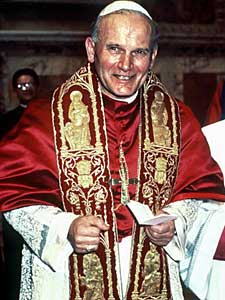Photos
| |||||||||||||||||||||
April 1, 2005
 |
| Pope John Paul II, former Polish cardinal Karol Wojtyla, at the Vatican after being named at the head of the Catholic Church, October 1978. (Photo by STAFF/AFP/Getty Images) |
—
Key dates in the life of Pope John Paul II.
May 18, 1920: Karol Joseph Wojtyla born in Wadowice, Poland.
Nov. 1, 1946: Ordained as a priest.
Sept. 28, 1958: Consecrated as auxiliary bishop of Krakow.
March 8, 1964: Installed as bishop of Krakow.
June 28, 1967: Elevated to cardinal by Pope Paul VI.
Oct. 16, 1978: Elected pope by cardinals, first Pole ever and
first non-Italian in 455 years.
Jan. 25, 1979: First trip abroad, to Dominican Republic, Mexico,
Bahamas.
June 2, 1979: Goes to Poland for first time as pope, setting off
sparks that help establish Solidarity, first independent labor
movement in Soviet bloc.
May 13, 1981: Shot in abdomen by Turk in St. Peter's Square.
Sept. 15, 1982: Receives Palestine Liberation Organization
leader Yasser Arafat at Vatican, provoking criticism from Israel
and Jewish groups.
April 13, 1986: Makes historic visit to Rome's main synagogue.
Dec. 1, 1989: Meets Mikhail Gorbachev at Vatican, first ever
meeting between a pope and a Kremlin chief.
May 1, 1991: Issues first encyclical on social issues since fall
of communism in Europe, giving qualified approval to capitalism but
warning rich against taking advantage of poor.
July 15, 1992: Operation for benign tumor on colon. Leaves
hospital July 28.
Sept. 4-10, 1993: Visits former Soviet Union for first time,
traveling to Baltic countries of Lithuania, Latvia, Estonia.
Oct. 5, 1993: Issues encyclical "Splendor of Truth," his major
statement on morality, cracking down on dissent.
Dec. 30, 1993: Agreement signed establishing formal ties between
Israel and Vatican.
Oct. 19, 1994: Publishes his book, "Beyond the Threshold of
Hope."
March 3, 1995: Issues encyclical "Gospel of Life," and
condemns spreading "culture of death," including abortion,
euthanasia, experimentation on human embryos.
March 10, 1997: Vatican establishes diplomatic relations with
Libya, overriding U.S. objections.
Jan. 21-26, 1998: Visits Cuba for first time.
March 16, 1998: Vatican issues "We Remember: A Reflection on
the Shoah," or Holocaust, expressing remorse for cowardice of some
Christians during World War II but defending actions of wartime
Pope Pius XII.
Oct. 19, 1998: Celebrates 20th anniversary as pope, asks for
prayers to fulfill his mission "until the end."
Dec. 24, 1999: Ushers in Vatican millennium Jubilee year by
opening Holy Door at St. Peter's Basilica.
March 20-26, 2000: Makes first trip to Holy Land. In note left
at Jerusalem's Western Wall, expresses sorrow for suffering of Jews
at Christian hands.
Sept. 3, 2000: Beatifies much-attacked Pope Pius IX and
much-loved Pope John XXIII in one of most disputed acts of papacy.
May 4, 2001: Becomes first pope to visit Greece since Schism;
issues sweeping apology for "sins of action and omission" by
Roman Catholics against Orthodox Christians.
April 23, 2002: Summons U.S. cardinals to discuss sex abuse
scandal, tells them there is no place in priesthood for clerics who
abuse young.
May 17, 2003: Cardinal, in newspaper interview, confirms pope
has Parkinson's disease.
June 5-9, 2003: Makes 100th foreign trip, visiting Croatia.
July 31, 2003: Vatican launches global campaign against gay
marriages.
Feb. 22, 2005: Pope's newest book, "Memory and Identity," is
officially launched. Describes for first time moments after being
shot in 1981, saying he was "almost on the other side" but
thought he'd live.
(Copyright 2005 by The Associated Press. All Rights Reserved.)







